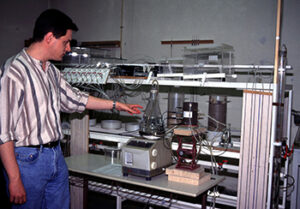Free shipping
No products in shopping cart
Continue shopping
Water never flows from our faucets in its purest form (H2O). In nature, water flows both under and above ground. It absorbs trace elements of everything it passes through. This includes minerals essential to our bodies.

One of these minerals is calcium carbonate. If there is too much calcium carbonate in the water, we refer to it as hard water. While the degree of hardness of water doesn’t reduce the water’s quality, it does affect household appliances. When hard water is heated or evaporates and comes into contact with oxygen, it forms lime scale. Lime scale then settles on pipes in the house and in home appliances, causing unwanted damage. In nature, water not only picks up trace minerals, but also traces of other substances with which it comes into contact. These substances vary greatly from one area to another.
Almost all drinking water is a mixture of surface water, spring water, ground water and clarified water. But other components of drinking water, including minerals and chemical compounds, vary immensely. Often, our tap water contains residue from detergents, fertilizers, pesticides, sewage, industrial waste water, antibiotics, pharmaceutical drugs, hormones, bacteria, microorganisms, heavy metals, uranium, and other contaminants. In excess, over time many of these pollutants can cause illness.
In addition to these environmental contaminants, metal and bacteria from pipes through which water passes, nickel used in faucets, and even energy fields from wiring in our homes, can affect water quality. Especially in older buildings where lead and other harmful metals may be present, make sure to let your water run for a while before drinking it.

You can only tell if water is contaminated in rare cases. Cloudiness, discoloration, or particles suspended in water may be signs of contamination. Most of the time, however, contaminated water can’t be detected by sight or taste. Smell, however, can be helpful. Pure water is odorless. If your tap water isn’t odorless, you should avoid drinking it and send it to a laboratory for testing. As a rule of thumb, where health is concerned, it is always preferable to err on the side of caution. If you aren’t sure whether your water is clean, have it tested.
We recommend:
Accurate Testing Laboratory, LLC (http://www.accuratetesting.com/)
and
Community Environmental Laboratories, Inc. (CEL) (http://www.watertestinglabs.com/).
You can also find a State-certified lab near you by calling the Safe Drinking Water Hotline at 1-800-426-4791 or by consulting the United States Environmental Protection Agency website at: www.epa.gov/safewater/labs. State health department web pages also often list certified laboratories for private home testing.